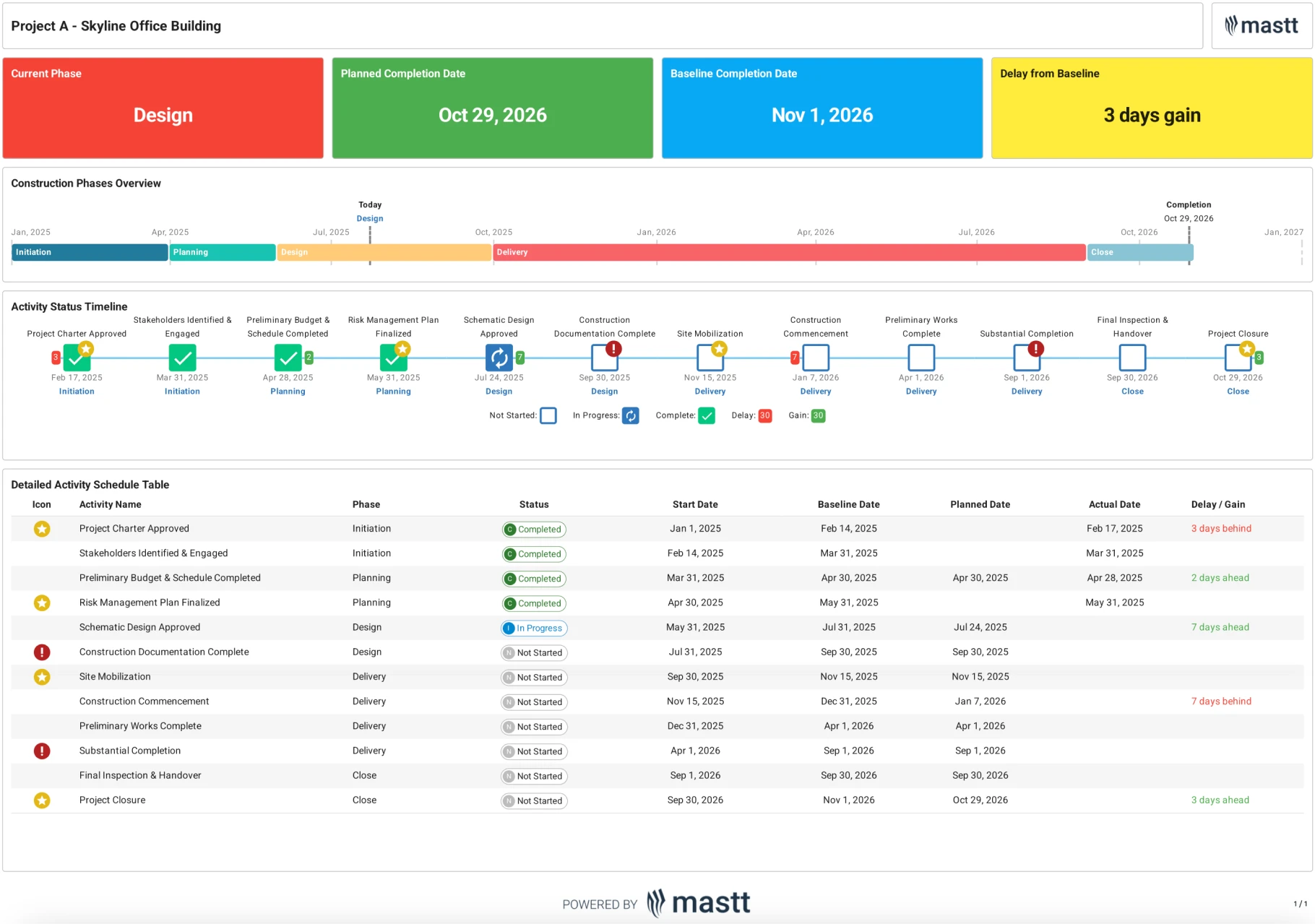In the construction industry, time impact analysis (TIA) is a crucial tool for assessing potential delays and managing their effects on project timelines. Even with meticulous planning, projects can encounter unexpected disruptions - ranging from resource shortages to adverse weather or design changes. TIA provides a structured approach to evaluate how these delays might affect the overall project scheduling and how to mitigate their impacts.
In this guide, we’ll explore what TIA is, how to perform it, and why it’s essential for successful project management. Understanding this process can help you save time, manage resources effectively, and, perhaps most importantly, keep projects running smoothly.
What is Time Impact Analysis (TIA)?
Time Impact Analysis is a schedule delay method used to assess how specific events affect a project's critical path and completion date. It inserts a delay into the baseline construction program and recalculates the outcome. Project owners, consultants, and contractors use it to justify or dispute extension of time (EOT) claims based on real project data.
TIA method evaluates the time consequences of delays using logic-based CPM scheduling and forensic techniques:
- Identify a delay event, like late approvals or site access issues
- Insert the delay into the approved baseline or current schedule
- Rerun the program to see changes in critical path and float
- Compare the original and impacted completion dates
- Use findings to support or challenge EOT claims
TIA is a forward-looking analysis, often used in live projects or during disputes. The contractor models the delay using scheduling software, applies logic ties, and proves if the delay affects project delivery. If it does, it forms the basis of a time entitlement. If it doesn’t, the claim may be rejected.
In government, infrastructure, and major capital projects, TIA is accepted as a formal delay analysis technique under most standard construction contracts. It provides a clear, traceable audit trail showing how delays affect program logic and outcomes.
Why Time Impact Analysis Matters in Construction Projects
Time impact analysis is more than just a scheduling term. It’s a methodology that helps project managers evaluate the impact of potential delays before they spiral out of control.
For instance, if a project experiences delays due to uncontrollable factors, the project manager can use time impact analysis to determine how those delays will affect the project completion date and adjust the schedule accordingly.
Without TIA, construction projects are vulnerable to cascading impacts that affect budgets, resources, and deadlines. Whether in the planning stages or mid-project, TIA provides project teams with a proactive tool to avoid costly overruns and missed deadlines.
Key Steps in Performing a Time Impact Analysis
So, how does one actually conduct a time impact analysis? Let’s break it down:
1. Identify the Delay Event
Begin by identifying the event causing the delay. Was it a resource issue, a weather problem, or a design change? This step is crucial for documenting the origin of the delay to analyze it accurately.
2. Develop a Fragnet
Create a fragmentary network or fragnet that represents the added or changed work due to the delay. This fragnet is a subset of the schedule consisting of the activities and logic relationships representing the impacted work.
3. Select the Appropriate Schedule Update
Identify which schedule update to impact. Generally, the appropriate schedule should be the last accepted schedule statused prior to the date of the impact. This schedule serves as the reference point from which the delay will be measured.
4. Insert the Fragnet and Recalculate the Schedule
Insert the fragnet into a copy of the unimpacted schedule and recalculate the Critical Path Method (CPM) schedule. Compare the completion date of the impacted schedule with that of the unimpacted schedule to determine the effect of the change.
5. Develop a Mitigation Strategy
Once you understand the delay’s potential impact, develop a response plan. Should resources be reallocated? Should tasks be rescheduled? A solid mitigation strategy can often save days or even weeks in the project timeline.
6. Review and Communicate Findings
Finally, share the findings with your team and stakeholders. Communicating project status and potential setbacks is essential for keeping everyone informed and engaged.
Think of TIA construction as a routine “health check” for your project. Regularly assessing potential impacts and adjusting plans proactively can make a world of difference.
Common Types of Delays in Construction and How TIA Helps Address Them
Construction projects encounter a range of delays, and TIA can address them effectively. Here are some common types:
- Weather Delays: Unpredictable weather can halt progress and significantly set back project schedules.
- Resource Shortages: Labor, materials, or equipment shortages can delay tasks that rely on these resources.
- Design Changes: When clients or regulatory bodies require design modifications, it can disrupt project timelines.
By applying TIA schedule analysis to each of these scenarios, project managers can assess the potential impacts and plan effective responses. TIA allows managers to respond proactively to delays rather than just reacting to them, minimizing their effect on project schedules.
How Time Impact Analysis Saved a Project Timeline
To bring this to life, let’s look at an example. Imagine a large construction project scheduled to complete in 12 months. Three months into the project, there’s an unexpected setback: a critical shipment of materials is delayed by two weeks.
The project manager springs into action, using time impact analysis to assess the delay. By integrating the delay into the project schedule, they realize that without adjustments, this delay could extend the project by three weeks, causing a domino effect on other tasks.
However, by reallocating certain tasks and shifting resources, the manager manages to reduce the delay’s impact to just one week.
By using TIA, the manager saved two weeks on the timeline, keeping the project closer to its original deadline. This is a great example of how TIA can turn a potential setback into a manageable adjustment.
Challenges in Implementing Time Impact Analysis and How to Overcome Them
Despite its benefits, TIA isn’t always easy to implement. Here are some common challenges and solutions:
- Data Gaps: Without historical data, it can be challenging to estimate the full impact of certain delays. Solution: Maintain a robust data collection process, tracking delays and other events to support future TIA.
- Resource Constraints: Smaller teams may lack the resources to conduct thorough TIA regularly. Solution: Prioritize critical delay events for TIA to manage workloads efficiently.
- Resistance to Change: Introducing TIA into a team’s routine may be met with resistance. Solution: Educate your team on the benefits of TIA and show how it can save time and resources in the long run.
Best Practices for Accurate Time Impact Analysis
To get the most out of time impact analysis, follow these best practices:
- Documentation is Key: Keep thorough records of all delay events, including details on when, why, and how they occurred. This information is essential for accurate analysis.
- Regularly Update Project Schedule: Ensure your schedule is up-to-date with real-time information so that TIA reflects current project status.
- Communicate Findings Effectively: Don’t just keep TIA results to yourself—share them with your team and stakeholders so that everyone understands the project status and can help prevent future delays.
Using Software for Effective Time Impact Analysis
In today’s fast-paced construction industry, project management software is invaluable for performing TIA. Many scheduling platforms have built-in functions for modeling delays and running “what-if” scenarios. By adjusting variables like task duration or resource allocation, managers can simulate delay impacts and view adjusted timelines immediately.
This kind of software enables project managers to conduct TIA quickly and accurately without digging through stacks of spreadsheets. (Let’s be honest, nobody misses those late nights squinting at Excel cells!) By visualizing delays in real time, software tools streamline TIA, helping everyone stay on the same page.
The Role of Time Impact Analysis in Successful Project Management
In summary, time impact analysis is an essential tool for construction project managers aiming to keep their projects on track. By identifying delays, evaluating their impacts, and developing strategies to mitigate them, TIA supports proactive project management and helps avoid costly overruns.
For any construction team looking to improve their scheduling practices, implementing TIA is a smart and valuable step.
















.avif)


